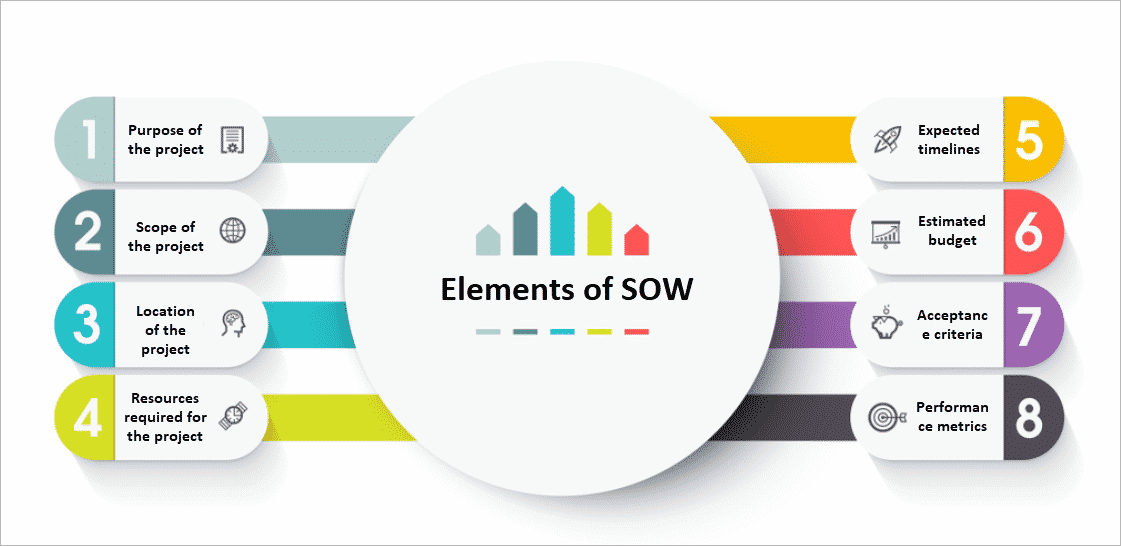Project scope forms an important aspect of every project; without a well-defined scope, projects are not feasible. The statement of work or SOW is a legal document that describes the scope of the project as well as all elements involved in the execution of the project. It is the primary document created at the beginning of a project by project management professionals. This makes the statement of work the most important document in project management. SOW in project management should not be confused with other documents like Project Charter and Work Breakdown Structure (WBS) in project management. A brief outline of the statement of work is discussed below.
Jump ahead to
What is a Statement of Work?
A statement of work or SOW is a legally binding document that specifies all the activities and responsibilities of the vendors and the project management (PMP) team. This document is needed when external contributors is needed to complete a project. Project managers create an SOW as a part of a contract or a bid document. SOW describes all aspects of the execution of a project including the project scope, budget, and time. All project stakeholders must approve the SOW before the project execute.. Thus, project managers create a statement of work before creating the structure of the project plan which is needed to complete the project.
Elements of Statement of Work

SOW describes the project scope in detail and all the deliverables included in the execution of the project. It is a formal document that details the project requirements, terms of payment, location details, and acceptance criteria. The SOW is finalized after conducting a negotiation with the project stakeholders and the project management team. This helps in risk mitigation and avoidance of disputes in the future.
Every statement of work must include the following elements:
- Purpose of the project
- Scope of the project
- Location of the project
- Resources required for the project
- Expected timelines
- Estimated budget
- Acceptance criteria
- Performance metrics
There are several templates for creating a statement of work, they change depending on the nature or specific requirements of the project. The statement of work must be as detailed as possible to avoid any confusion or conflict during the execution of the project. It must be noted that without the approval of SOW by the stakeholders and the clients a project cannot be executed. Therefore, project managers should prepare the statement of work with careful attention.
Types of Statement of Work
There are three types of SOWs that organizations use for defining the scope and deliverables of the project. These are as follows:
Design or Detail
This SOW describes the specific requirements of the project. It helps vendors and the project management team know all the requirements of the project including the steps to execute the project.
Level of Effort
This is the most used statement of work and applies to all projects irrespective of the industry. It describes the work hours and materials required to execute the project.
Performance-based
This type of SOW is based on the performance of the project and is preferred by project managers. It describes the project’s purpose, resources needed, and the deliverables that will be achieved. This statement of work allows flexibility and allows the shared responsibility in risk mitigation and risk management.
Steps to write an SOW in Project Management
A statement of work must include all the necessary information associated with the project scope. Project managers are skilled in identifying the details and creating the SOW for the approval of a project. Here are the steps that project managers follow to write a statement of work for a given project:
Provide a brief introduction
Project professionals are required to provide a brief overview of the project and the work that needs to be completed. They also introduce people involved in the project such as stakeholders and clients as well as details about agreements.
Define the purpose of the project
Project managers are necessitated to define the purpose of the project. This allows them to set project goals and clear objectives. In addition, this helps in identifying customer requirements and the final deliverable.
Describe the scope of the project
Describing the scope of the project is the foundation of the planning process. Project managers need to describe the scope of the project including the process and steps involved in completing the work defined in the scope, as well as the project’s outcomes and time frame.
Create a WBS (work breakdown structure)
Project managers should split complex tasks into small activities using a work breakdown structure to produce deliverables and accomplish the project objectives. They should also include the amount of time allotted to accomplish the project and describe deliverables.
Define the estimated time for project completion
It is important for professionals in project management to complete projects on time. Project Managers should set a timeline to complete the project. It should include project start dates, task due dates, major milestones, and project completion dates.
Define the acceptance criteria and success metrics
Project professionals should define success metrics to measure project progress and specify industry acceptance criteria or quality standards that have to be satisfied. Furthermore, if the product is being tested, they should specify who will be participating in the acceptance testing process, what equipment is required, and other resources.
Establish the budget of the project and the payment conditions
Professionals in project management must create a budget for each activity engaged in the project. Then they must list the project payments and how they will be distributed – in advance, over time, or after completion.
In order to create a good statement of work document all the elements of SOW must be included. Sometimes location and resources requirements are also mentioned in the statement of work document. The details change with the nature or requirements of the project. This document lays the foundation for the project plan, so project managers invest their time carefully while writing SOW. The statement of work can also include graphs and charts to make the details clear and comprehensible to all the stakeholders.
Advantages of a Statement of Work
Creating a well-defined SOW form the first step towards the execution of any project. However, a good statement of work can provide many other benefits. Here are a few advantages of a SOW:
- A well-written statement of work allows organizations to make informed decisions about buying and building trust with suppliers and vendors.
- It helps in reducing costs and maximizing productivity.
- It also helps in risk mitigation & risk management and avoiding disputes during the execution of the project.
- SOW forms the foundation of the project plan and ensures that the project will be completed on time.
Conclusion
A statement of work in project management forms an integral part of project planning. After determining the project scope, project managers create an SOW document to detail all the deliverables of the project. This will help stakeholders understand all aspects of the project and allow the approval of the project if it meets their expectations. Therefore, a well-written SOW helps project managers in executing a project with all the details described in a formal document.



